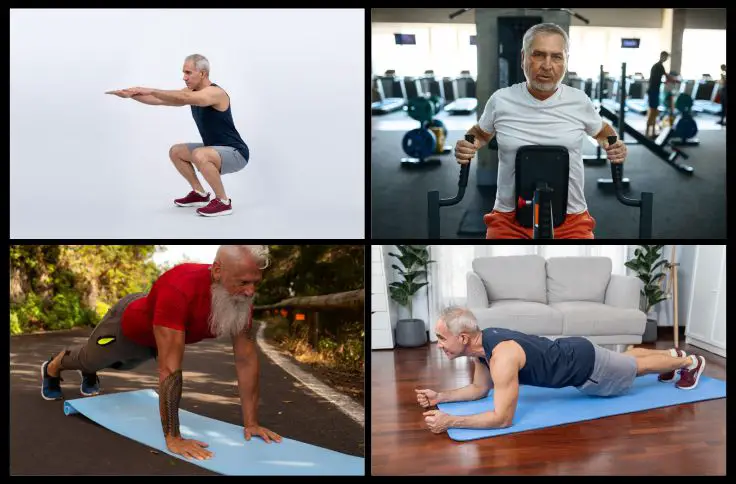Last updated on November 17th, 2025 at 04:35 pm
Struggling with muscle loss and low energy? Strength training for men over 50 tackles aging concerns by building strength, improving balance, and restoring vitality with safe, effective workouts tailored for you.
Strength training for men over 50 is a powerful tool for revitalizing both body and mind.
It’s not about lifting heavy weights or competing with younger generations, but about maintaining and improving your muscle mass, bone density, and overall vitality.
Many men believe strength training is too intense for their age or worry about injury, but the truth is, it can significantly improve their quality of life when done safely.
With the right approach, strength training helps enhance balance, boost metabolism, and increase energy, making everyday tasks easier.
Whether you’re a beginner or returning to the gym, it’s never too late to start.
This article will provide practical tips, safe exercises, and strategies to help you build strength and age confidently, proving that it’s possible to get stronger as you grow older.
Recommended: Fitness for Older Men
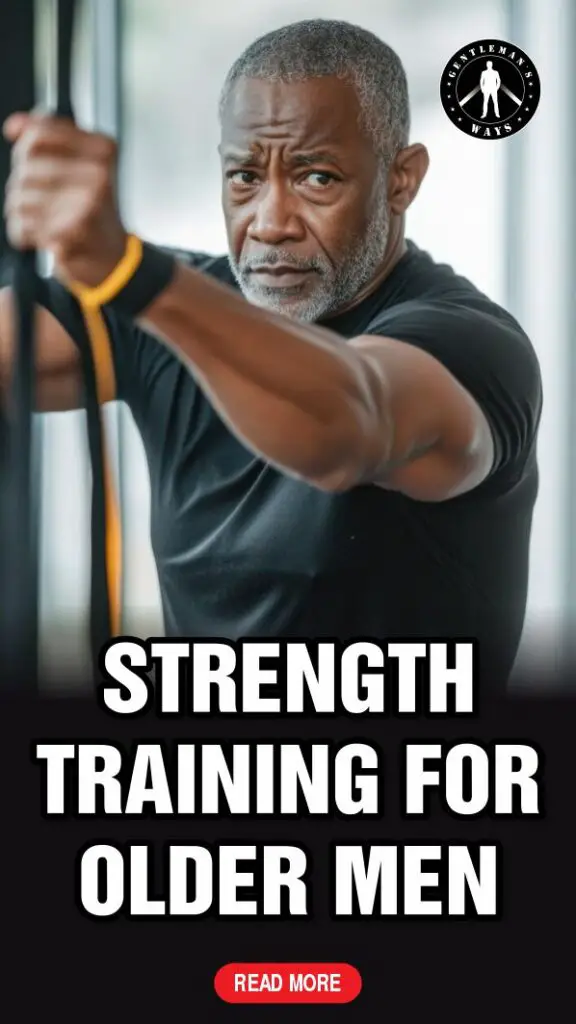
Table of Contents
- Main Points
- What is Strength Training, By the Way?
- The Importance of Strength Training for Men Over 50
- The Science Behind Strength Training After 50
- Strength Training Principles for Men Over 50
- Essential Strength Training Movements
- Strength Training Equipment for Older Men
- Weekly Strength Training Template
- Mistakes to Avoid When Starting Strength Training at 50
- Benefits You’ll Start to Notice
- When to Talk to a Professional
- Frequently Asked Questions
- Conclusion
Main Points
- Strength training helps counteract muscle loss, builds bone density, and enhances overall vitality, benefiting both body and mind after 50.
- Proper strength training involves gradual progression and correct form, ensuring safe muscle growth while minimizing the risk of injury.
- Essential movements like push, pull, and lower body exercises target key muscle groups, improving mobility, strength, and posture for older men.
- Incorporating strength training boosts energy, supports metabolism, and enhances balance, making everyday tasks easier and promoting longevity for men over 50.
Recommended: Cardio Exercises for Older Men
What is Strength Training, By the Way?
Strength training, or resistance training, focuses on exercises that build muscle strength by applying resistance to muscle movement. It can be done using free weights, resistance bands, weight machines, or even your body weight.
The idea is to gradually increase the challenge, encouraging muscle growth, boosting endurance, and improving overall physical strength.
Incorporating strength training into your routine helps build muscle, support metabolism, increase bone density, and improve balance.
It’s a key part of staying fit, particularly as we get older, helping you maintain strength and mobility for daily activities.
Related: Best Dating Tips for Older Men
The Importance of Strength Training for Men Over 50
Strength training is a game-changer for men over 50, offering numerous health benefits beyond just building muscle.
Here are five reasons why incorporating strength training into your routine is essential for maintaining health, vitality, and independence as you age:
- Combats Muscle Loss (Sarcopenia): As men age, muscle mass naturally declines. Strength training helps counteract this process, preserving and even building muscle to maintain functional strength and support daily activities.
- Improves Bone Health: Weight-bearing exercises strengthen bones, increasing bone density and reducing the risk of osteoporosis. This is especially important for older men to prevent fractures and maintain mobility.
- Boosts Metabolism: Building muscle through strength training increases your basal metabolic rate (BMR), helping to burn calories more efficiently. This can aid in weight management and prevent age-related weight gain.
- Enhances Balance and Coordination: Strength training improves core stability and coordination, reducing the risk of falls and improving overall movement efficiency, which is crucial as you age.
- Promotes Heart Health: Regular strength training helps lower blood pressure, improve circulation, and reduce the risk of heart disease, which is vital as cardiovascular health becomes more of an age concern.
Recommended: Must-Have Wardrobe Essentials for Older Men Over 50
The Science Behind Strength Training After 50
As you count the ages, especially after 50, you start noticing changes in your body.
One of the most significant is muscle loss, a process known as sarcopenia.
This happens naturally over time due to reduced physical activity, hormonal shifts, and sometimes poor nutrition.
With age, your body produces fewer key hormones like testosterone and growth hormone, both essential for maintaining muscle health.
As these levels drop, muscle mass can decrease, leading to weaker muscles and an increased risk of injuries.
How Strength Training Helps
Strength training is one of the most effective ways to combat muscle loss.
Studies show that even light resistance exercises can significantly boost muscle mass and strength in older adults.
This type of exercise stimulates muscle fibers and helps release hormones needed for muscle repair and growth.
Strength training can also help balance hormones, including testosterone, which is especially important for men over 50.
Higher testosterone levels not only support muscle growth but also improve your mood and energy.
Related: How to Stay Attractive and Confident as You Age
Strength Training Principles for Men Over 50
Strength training is a great way to keep your body strong and functional as you age.
But to get the most out of it, you should keep a few principles in mind.
Progressive Overload: Gradual Challenges for Maximum Results
Progressive overload is a simple but powerful concept: gradually increasing the weight or resistance in your exercises.
This doesn’t mean jumping into heavy lifting right away, but rather making small, steady adjustments to challenge your muscles without overwhelming them.
For men over 50, this slow and steady approach helps build muscle and strength without risking injury.
Perfecting Form: Protect Your Joints and Boost Effectiveness
Yes, you are not as agile as you were in your 20s, even though you might be at heart.
Proper form is crucial when lifting weights. Using the right technique prevents injuries and ensures you’re getting the most out of each movement.
If you’re new to strength training or want to refine your form, working with a trainer or using quality resources can help.
Focus on exercises that are gentler on your joints to further protect your body while improving strength.
Recovery: Give Your Muscles Time to Grow
Recovery is just as important as the workout itself. Your muscles need time to repair and grow stronger, and as you age, you may need more recovery time than younger people.
Pay attention to your body and adjust your routine if necessary.
Take rest days, add low-impact activities like walking or swimming, and prioritize quality sleep to support muscle recovery.
By following these principles, progressive overload, proper form, and recovery, you’ll set yourself up for a safe and effective strength training routine that helps you age strong and healthy.
Related: How to Maintain Balance and Flexibility for Seniors
Essential Strength Training Movements
Strength training becomes more important as you get older, especially after 50.
It helps you maintain muscle mass, supports your joints, and improves your overall quality of life.
Understanding key exercises for different muscle groups can make your strength training routine more effective.
Push Movements: Target Your Upper Body

Push movements, such as the dumbbell press and overhead press, are effective for strengthening your chest, shoulders, and triceps.
The dumbbell press, which can be done seated or lying down, is an excellent choice for building upper-body strength while minimizing the risk of injury.
Start with light weights and gradually increase as your strength improves.
The overhead press targets the shoulders and upper back, which helps with stability.
According to the National Institute of Health, push movement exercises improve functional strength and posture, making them vital for older adults.
Pull Movements: Strengthen Your Back and Arms
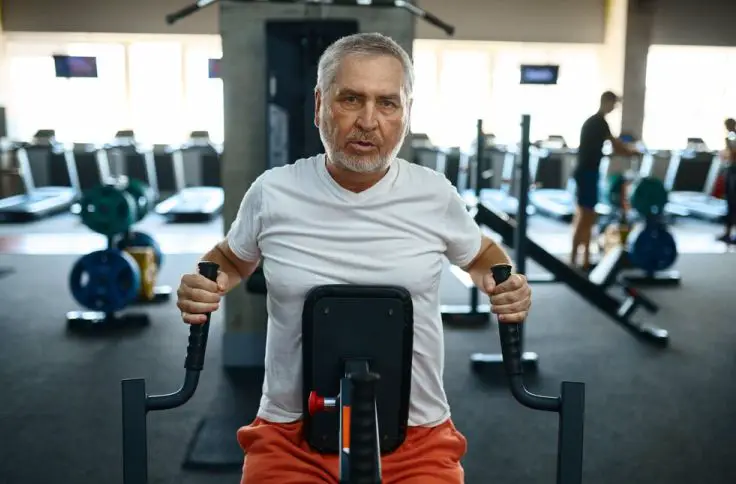
Pull exercises focus on your back, biceps, and forearms.
Resistance band rows are particularly beneficial for men over 50, offering controlled motion and adjustable resistance levels.
These rows help build back strength, improve posture, and reduce the risk of injury.
According to the Wiley Online Library, resistance training, including band exercises, is effective in enhancing muscle mass and strength in older adults.
Lat pulldowns are also a great way to target the same muscle groups and can be modified for various fitness levels.
Recommended: Functional Fitness Exercises for Men Over 50
Lower Body Exercises: Boost Mobility and Balance

Maintaining lower body strength is vital for mobility and balance, especially as you age.
Goblet squats are an excellent way to target the quads, hamstrings, and glutes, all of which are crucial for walking, standing, and maintaining balance.
Holding a dumbbell or kettlebell close to your chest while squatting improves stability and posture.
Lunges, whether forward or backward, also contribute to lower-body strength.
A study on resistance training in older adults highlights that such exercises improve functional movements, reduce falls, and enhance balance
Core Workouts: Build Stability and Posture
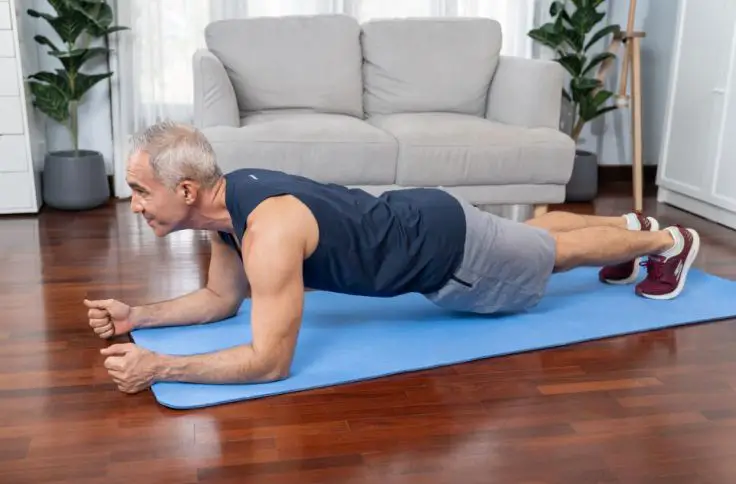
Core strength is essential for overall stability, posture, and injury prevention.
Planks are an effective way to strengthen the core while also boosting endurance.
Planks can be modified to suit different fitness levels, from beginner to advanced.
Side planks are another great variation that engages different parts of the core, promoting balanced muscle development.
Studies support that regular core workouts improve posture and reduce the risk of back pain.
Using instructional videos or guides can help you better understand these exercises and perfect your form.
Adding these movements to your routine will support healthy aging and improve your physical performance.
Related: Men’s Health and Wellness
Strength Training Equipment for Older Men
For older men who are in their 50s and beyond, choosing the right strength training equipment becomes key to staying fit and healthy.
The right tools will help you work out safely and effectively, boosting muscle strength, stability, and overall health.
You can set up your workouts at home or join a gym, each with its own set of benefits.
Home-Based Equipment: Convenient and Flexible
Under-Desk Elliptical Machine
This compact seated elliptical lets you exercise your legs and improve circulation from a chair, ideal for joint sensitivity or limited mobility.
Its quiet motor and adjustable resistance support gentle cardio and muscle tone.
A remote control lets you switch speeds without standing.
Users report reduced hip and knee stiffness and better energy levels.
It’s easy to store and safe for seniors. Before purchase, confirm noise levels and speed range suit your needs.
Adjustable Dumbbell Set (4–44 lb)
Spin-lock adjustable dumbbells offer versatility in weight choices, from light lifts to moderate resistance.
The anti-slip iron handles and secure collars make changing plates easy and safe.

Perfect for older adults who want progression without clutter or the cost of multiple dumbbells. Ideal for biceps, triceps, shoulder work, and more.
Compact design fits small spaces. Ensure you choose an appropriate initial weight and progressively increase it as strength improves. Shop for an adjustable dumbbell here.
Resistance Bands Set

A set of five loop bands gives graduated resistance for gentle to firm tension across muscle groups.
They’re light on joints and portable, great for strength, stretching, and rehab.
Bands are ideal for older men to stay active at home or on the go.
Use for seated rows, chest pulls, leg presses, and more.
Check for latex-free options if you’re sensitive. Durable material offers consistent pull without snapping.
Adjustable Weighted Vest
A vest with metal sandbag inserts adds manageable resistance to bodyweight movements and walking.
You can remove or add weight, starting light and building safely.
Especially useful for boosting core and shoulder training without gym machines.
Soft straps and reflective strips increase comfort and visibility. Trainers recommend wearing vests to enhance muscle and bone strength when used correctly.
Always begin with a light load and monitor posture and breathing.
Foldable Adjustable Weight Bench
A foldable bench with incline, flat, and decline positions supports presses, rows, and seated lifts.
Made from steel with locking safety pins and a padded surface for comfort and stability. Ideal for older users who want strength training but need occasional support.
Its foldable frame saves space and is easy to store. Look for benches rated for at least a 300 lb combined load and check pad thickness for comfort.
These pieces of equipment allow you to design a workout routine tailored to your needs and schedule.
Gym-Based Equipment: Access to Specialized Machines
If you prefer a gym, you’ll find a broader selection of machines designed to improve stability and safety.
Gym machines like leg presses and seated row machines are great for maintaining proper form and reducing injury risk.
Some gyms even offer resistance machines specifically built for seniors, with easy-to-adjust settings and built-in safety features.
This equipment can be especially helpful if you’re new to strength training or wary of lifting free weights.
Home vs Gym: Which One to Choose?
Deciding between a home gym and a gym membership depends on your preferences, budget, and access to facilities.
Both setups have their benefits. At home, you have flexibility and convenience, while a gym offers a wider variety of equipment, often with expert support.
No matter which route you take, be sure to use equipment that supports safe and effective workouts.
Gradually increasing your workout intensity will help you maximize the benefits of strength training as you age.
Weekly Strength Training Template
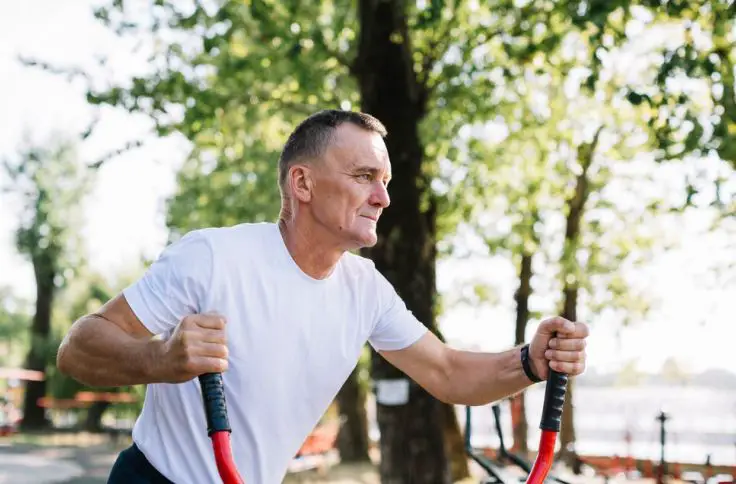
Adopting a structured weekly strength training routine is essential for men over 50 seeking to improve their physical health and promote longevity.
To create an effective yet adaptable framework, this section presents a straightforward 3-day full-body split workout plan.
This regimen emphasizes strength building while taking into account the unique recovery needs of aging bodies.
Each training session focuses on key muscle groups, ensuring a balanced approach. The following weekly schedule can serve as a guideline:
- Day 1: Upper Body Focus
- Day 2: Lower Body Focus
- Day 3: Full Body Integration
Prior to each workout, a proper warm-up is crucial.
It is advisable to spend about 10 minutes engaging in light aerobic activities, such as brisk walking or cycling, followed by dynamic stretches targeting the major muscle groups.
This preparation helps to enhance blood flow and reduce the risk of injury.
After each training session, implementing cool-down techniques, including static stretching and deep breathing exercises, aids in recovery and promotes flexibility.
As for the workouts themselves, a beginner-friendly progression plan can be established.
Initially, select weights that allow for 10-12 repetitions per exercise, aiming for 2-3 sets. Gradually, as strength improves, incrementally increase the weights or repetitions.
Tracking progress is beneficial; consider maintaining a training log, noting the weights and repetitions completed.
This practice not only provides motivational feedback but also assists in planning future workouts effectively.
By following this weekly strength training template, men over 50 can cultivate a sustainable fitness routine that contributes to enhanced strength, mobility, and overall well-being, ultimately unlocking the benefits of stronger aging.
Mistakes to Avoid When Starting Strength Training at 50
Starting strength training at 50 offers great benefits for your body and mind.
However, there are a few mistakes you should watch out for to avoid setbacks or injury.
By taking a mindful approach, you can make the most of your workouts and stay safe.
Skipping Warm-Ups: Take Time to Prepare Your Body
One mistake that many overlook is skipping the warm-up. As you get older, your body needs more time to get ready for physical activity.
A proper warm-up increases blood flow and flexibility, which helps prevent injuries during your workout.
Incorporating light cardio and dynamic stretching before lifting weights can set you up for success.
Lifting Too Heavy, Too Soon: Gradual Progress Is Key
Another common mistake is jumping into heavy lifting too quickly.
It’s important to start with manageable weights that match your fitness level.
This allows your body to adjust and build strength safely over time.
By gradually increasing the weight, you reduce the risk of strain or injury while building strength at a steady pace.
Neglecting Flexibility and Mobility: Focus on More Than Just Strength
Strength training is important, but it shouldn’t be your only focus.
Failing to include flexibility and mobility work in your routine can lead to muscle imbalances and joint problems.
Incorporate stretching exercises and mobility drills to keep your muscles and joints healthy.
This balanced approach will improve your overall performance and keep you moving freely.
Comparing Yourself to Younger Individuals: Set Realistic Goals
It’s easy to compare your progress with others, but doing so can discourage you.
Your body responds to training differently from someone younger.
Instead of comparing, focus on your progress. Set realistic goals and celebrate your improvements, no matter how small they may seem.
Tracking your achievements will keep you motivated.
Not Seeking Professional Guidance: Get Help When Needed
If you’re unsure where to start or how to structure your workouts, consider consulting a certified trainer.
A professional can help you design a program that fits your specific needs and avoid common mistakes.
They can also teach you proper form, reducing your risk of injury.
By steering clear of these mistakes, you’ll get the most out of your strength training routine.
Focus on warming up, lifting gradually, balancing strength with flexibility, setting personal goals, and seeking guidance when needed.
This will ensure a safe and effective workout experience as you age.
Benefits You’ll Start to Notice
Strength training can bring noticeable improvements for older men.
By staying consistent with your workouts, you’ll soon see how it positively impacts your daily life and well-being.
Easier Daily Activities: Move with Ease
As you build strength, simple tasks like lifting, walking, or climbing stairs will feel easier.
You’ll notice you can do these things without discomfort, giving you more independence.
This improvement also boosts your sense of accomplishment, making everyday activities feel less challenging.
Boosted Energy: Stay Active and Motivated
One of the most rewarding benefits is the increase in energy levels.
Regular strength training helps your body respond with more stamina and vitality.
This extra energy opens the door to more activity and participation in hobbies or social events.
Plus, you’ll likely feel more motivated and engaged, lifting your overall quality of life.
Better Posture: Stand Tall and Confident
Strengthening your core and back muscles has a direct effect on posture.
Improved posture aligns your spine better and helps reduce back pain, a common issue for men over 50.
Besides the physical benefits, better posture boosts your self-confidence when standing or interacting with others.
Faster Metabolism: Burn More Calories
With strength training, your muscle mass increases, which in turn helps your body burn more calories even when you’re not working out.
This metabolic boost supports weight management and fat loss efforts, making it easier to maintain a leaner physique as you age.
Overall Improvement: Feel Better, Move Better
Together, these benefits, improved functionality, more energy, better posture, and a faster metabolism, can have a big impact on your life.
Strength training for men over 50 isn’t just about lifting weights; it’s about enhancing your overall health and daily experience.
When to Talk to a Professional
Starting strength training after 50 can be a game-changer for your health.
However, knowing when to consult a professional ensures that you stay safe and make the most of your workouts.
Here are some signs that it’s time to seek expert advice.
Chronic Health Conditions: Get Medical Clearance
If you have chronic conditions like heart disease, diabetes, or arthritis, it’s important to get medical clearance before starting a workout routine.
A healthcare provider can help you understand what exercises are safe for you.
A personal trainer or physical therapist can further tailor your program to accommodate your condition and ensure safety while working out.
Pain or Discomfort: Don’t Push Through
Pain during exercise is a signal that something isn’t right. If you experience ongoing discomfort or strain, it’s time to seek professional help.
A certified trainer or physical therapist can analyze your movements, identify any issues, and guide you on proper form.
They’ll also recommend adjustments to avoid injury and help you get the best results from your training.
Beginners: Get the Right Start
If you’re new to strength training, starting with professional guidance can make all the difference.
A personal trainer can create a balanced plan that aligns with your goals and covers all aspects of fitness, from warm-ups to recovery.
They will also ensure you’re using the right form and progressing at a safe pace.
Finding the Right Coach: Look for Experience with Seniors
Not all trainers are familiar with the unique needs of men over 50. Look for trainers who specialize in working with older adults.
They should have experience designing safe and effective programs for seniors, focusing on mobility, stability, and strength.
Take the time to research credentials, ask for recommendations, and meet with potential trainers to discuss your goals and expectations.
Why Professional Help Matters
Having the right expert can transform your fitness journey. They can guide you on safe practices, avoid injuries, and help you stay motivated.
With the right professional by your side, your strength training routine will be more effective, safe, and rewarding.
Frequently Asked Questions
Why is strength training important for men over 50?
Strength training prevents muscle loss, improves bone density, enhances balance, and boosts metabolism, making it essential for maintaining health and independence as men age.
How do I start strength training safely?
Start with lighter weights, focus on perfecting your form, gradually increase intensity, and incorporate rest days for recovery. A gradual approach ensures safety and effectiveness, especially when new to strength training.
What exercises should I focus on after 50?
Focus on push movements (e.g., dumbbell presses), pull exercises (e.g., rows), lower body exercises (e.g., squats), and core workouts (e.g., planks) for balanced strength, mobility, and stability.
Is it too late to start strength training at 50?
No, it’s never too late. Starting strength training at 50 or older can significantly improve strength, energy, and overall quality of life, enhancing both physical and mental well-being.
Conclusion
Starting strength training after 50 can change your life. The key is consistency, not intensity. You don’t need to push yourself to extremes to see results.
A steady routine will improve your fitness, muscle mass, bone density, and metabolism.
The best part is that it’s never too late to start, whether you’re new to strength training or getting back into it, every small step adds up.
Strength training not only boosts physical health but also enhances energy, balance, and your ability to perform daily tasks.
It also improves your mental well-being by building confidence and a positive outlook.
So, why wait? Begin today, and you’ll notice improvements that will benefit your overall health as you age. Your future self will thank you.
References
- Wiley Online Library: Effectiveness of exercise interventions on muscle mass
Pyo Merez is a men’s lifestyle enthusiast and writer about the gentleman’s place and impact on society. Raised by a distinguished gentleman dad, he offers unique insights into how the mind of a gentleman works and how societal norms shape gentlemen’s identity and vice versa.
Through his insightful articles, Pyo taps into the depths of gentleman culture to provide perspectives on etiquette and manners in modern society.

